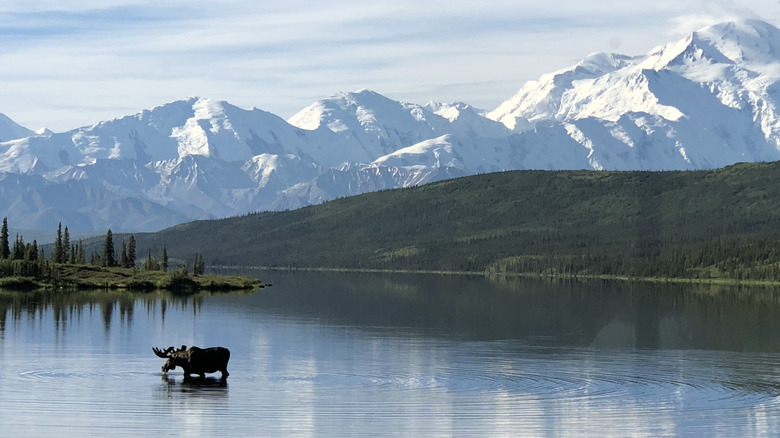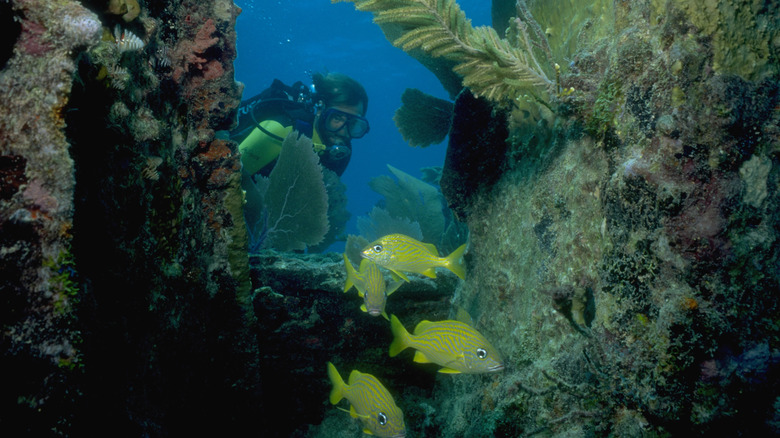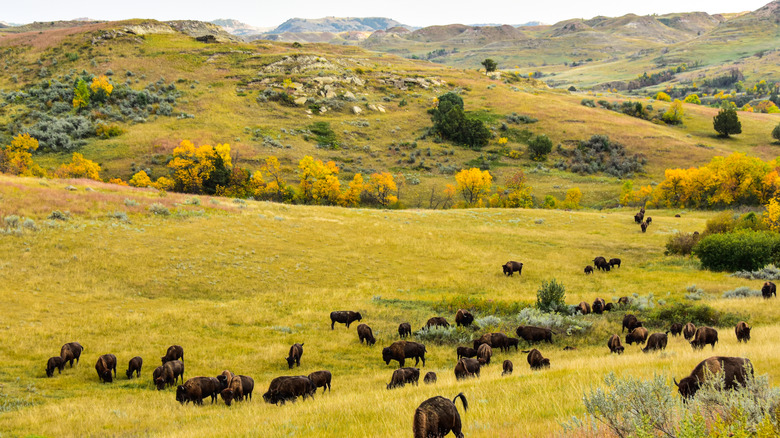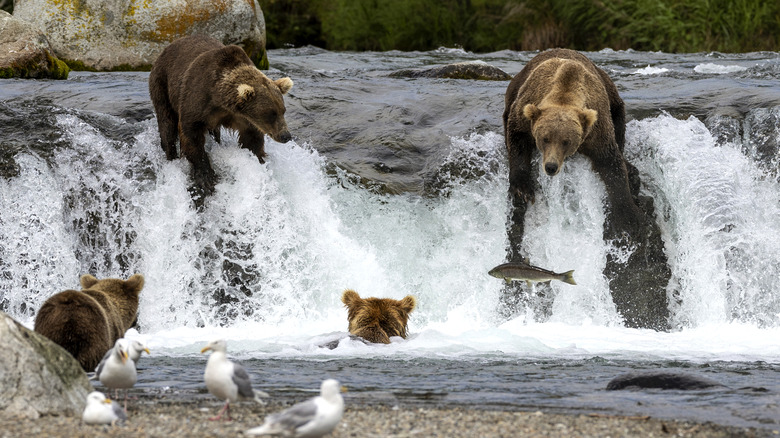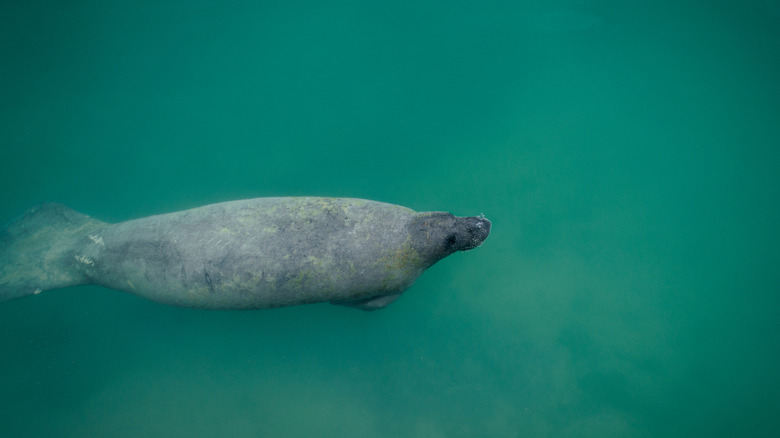These 5 Uncrowded US National Parks Are The Best To Spot Wildlife, According To Visitor Reviews
If you want to see incredible wild animals in their natural habitats, doing the things they have evolved to do over millions of years, there's no better place to go than a national park. U.S. national parks are designed to be protected places where the natural world can thrive and visitors can get a taste of the natural beauty of the land. While you can have spectacular wildlife sightings at any park, some parks are more known for it than others. To find the best ones for a transcendent, private experience with wild animals, we narrowed our search to less crowded parks and then scoured tens of thousands of reviews from actual park visitors for evidence of the best wildlife viewing experiences.
If you're planning a trip to see wildlife, and don't want to have to wade through crowds of people to do it, consider heading to Alaska to see dall's sheep, caribou, bears, and moose amidst towering mountain peaks in the massive Denali National Park & Preserve or making the journey to the remote Katmai National Park for the chance to see more bears in one place than anywhere else in the world. Travel to the grasslands of North Dakota to spot herds of bison and untamed horses. Take a boat trip off the coast of California to the mountainous Channel Islands National Park to see tens of thousands of seals and sea lions lounging on the beaches. Travel south to Florida to Biscayne National Park, where a staggeringly biodiverse world is waiting in the reef beneath the waves.
Denali National Park & Preserve
While most national parks provide the opportunity to connect with nature, few can make you feel as alone in the vast, awe-inspiring wilderness as Denali National Park & Preserve. Its 6 million acres are home to some of the most exciting wildlife you could hope to see. The National Park Service has dubbed five of these species "the big five" because of how much visitors long to catch a glimpse of them at Denali: moose, caribou, dall's sheep, wolves, and grizzly bears. The best way to explore Denali National Park on a tight budget is by one of the affordable park shuttle buses that takes you along the park's only road. While you will have to look for animals out the windows, the slightly higher vantage point makes it a lot easier to spot animals. It's safer too, considering there's glass between you and some of the biggest animals living in the United States.
"Wildlife encounters at the Denali National Park were a major highlight of our trip," one visitor on Google Reviews wrote. "On the guided bus tour, I had the thrilling experience of seeing a grizzly bear, moose, caribou, red fox, willow ptarmigans, spruce grouse, and some other wild animals in their natural habitat."
There's obviously no way to completely ensure that you'll see wildlife in Denali, but the odds are good. The National Park Service reports that in 2014, 70% of those riding into Denali on a shuttle bus spotted caribou, 66% saw grizzlies, and 63% dall's sheep. Only 29% saw moose, and a lucky 6% saw wolves. These impressive numbers are backed up by reviews from visitors on Tripadvisor and Google Reviews, very few of whom reported seeing little to no wildlife, and many of whom enthused about the animals they saw along the way.
Channel Islands National Park
Only a short boat ride from Santa Barbara, California is one of the most wild and fascinating national parks in the United States: Channel Islands National Park. This chain of small, mountainous islands is the ideal place to see animals that you might not get a chance to see elsewhere, up close and in their natural environment. This unique place, where the ocean meets the rocky, mountainous shore, is the perfect place to spot dolphins, whales, seals, and sea lions in the waves. On the shores, you will find animals here that have specifically evolved to live on these isolated islands, including the adorable island fox, which can be found nowhere else on the planet.
The most incredible wildlife watching opportunity can be found on the incredible Point Bennet Trail on San Miguel Island. Point Bennet is a beautiful beach, but as you approach you'll see something other than the crashing of waves on the sand: thousands of elephant seals. You may also see some of the tens of thousands of California sea lions and thousands of northern fur seals that live on and around the island lounging by the shore.
It's a long boat trip to get there, but that can be an opportunity for wildlife watching, too. One visitor posted on Reddit's r/SantaBarbara that a pod of dolphins seemed to follow them to the island, and once they arrived, the only footprints on the beach belonged to animals. You might see thousands of animals here, but other than the park ranger escorting you on your hike, you probably won't see a single person who didn't come to the island with you.
Biscayne National Park
When you picture wildlife watching in a national park, you might imagine yourself watching herds of grazing bison or spotting an eagle in the branches of a tall tree, but according to a ranking from Casago, created using data from the National Park Service, the most biodiverse national park is actually one of the least visited national parks: Biscayne National Park. 95% percent of the park is water, and the best wildlife there can only be found beneath the brilliant blue waves. This park is one of Florida's best snorkeling spots because it is home to a vibrant coral reef. Snorkelers typically spend time at the reefs, mangroves, or the multiple shipwrecks at Biscayne. Just make sure you know how to dive or snorkel safely around the coral reef so you can protect this incredible place and the creatures who live here.
While you'll certainly find a lot of the same bird watching opportunities and chances to see crocodiles and manatees as Biscayne's popular neighbor Everglades National Park on its land trails and paddling routes through the mangroves, it's the underwater parts of the park that reveal a breathtaking world teeming with life.
While at other parks you might have to watch attentively for hours to see signs of exciting wildlife, here you won't know where to look first. The vast coral reef is dotted with neon bright colorful fish. There are hundreds of species living here and you will see more and more the longer you look. One reviewer on Tripadvisor who visited both the reefs and several sunken ships enthused: "The fish were incredible and would just swim right next to you. There were SO many different types, colors, sizes of fish and plant life. On one there was a SHARK!"
Theodore Roosevelt National Park
If you're hoping to see herds of wild bison but aren't excited to also see hordes of fellow park visitors, you can skip Yellowstone National Park for North Dakota's Theodore Roosevelt National Park, an underrated park with stunning fall foliage, virtually no crowds, and plenty of opportunities to see incredible wildlife. You won't usually have any trouble finding them, since they are so abundant in the park, but if you want to head right to the right spot, stop in at a visitor center and ask where they've been seen recently. One Google Reviewer stated: "The bison here will walk right up to your truck while you sleep ... You might even get to see the wild horses."
Although not as commonly spotted as the bison, the herds of horses running free through the Badlands are of the most popular forms of wildlife in the park, despite actually descended from domestic animals. If you're interested in seeing elk and mule deer, explore the grasslands around Buck Hill at dusk or dawn. While these large, impressive animals might be the usual draws for visitors to the park, don't miss the little creatures, too. One Google reviewer recounted: "We hiked the Prarie Dog Town hike via the Buckhorn Trail...The experience of walking along the trail through the middle of a Prarie Dog Town was surreal."
Katmai National Park
Many national park visitors are overjoyed to spot a bear while exploring. At the utterly unique Katmai National Park, Alaska's rugged and remote national park that you need to charter a boat ride or a flight to reach because it is completely isolated from civilization, you might see 10 or 20 brown bears at once. This is because of the huge amount of salmon that come through certain parts of the park. Their struggles for dominance on Brooks Falls where salmon leap has become extremely popular through an Explore.org live cam, and now this iconic park is home to the Internet's favorite wildlife. Many visitors to the park come not just to see bears in general, but to see specific beloved bears whose stories they have followed since they were cubs.
"It was absolutely amazing to see so many bears at once. There was a bit of a wait to be able to watch the bears from the upper Brooks viewing point...but definitely worth it. We were able to see around 13 bears at once in the river which was incredible. A couple bears were even fighting in the river," one Google reviewer wrote. "There were bears everywhere, not only in the river but also rolling around on land, we even saw one climbing a tree! There were also multiple cub bears following their mothers which were so adorable."
Peak times for bear viewing at Katmai National Park are between June and September. While there can be a lot of visitors to the park at this time hoping to see their favorite bears in person, as the reviewer noted, the popular Brooks Camp is not the only spot for viewing. Hallo Bay is a perfect place to watch bears foraging for clams throughout the entire season.
Methodology
National parks are in general protected natural ecosystems, so you're almost guaranteed to see some interesting wildlife. Using the official species checklists from the National Park Service, we prioritized parks that have impressive species that people travel around the world to see like the bears of Katmai National Park or the bison at Theodore Roosevelt National Park, notably extreme biodiversity and unique habitats that provide the opportunity to see a huge number of different kinds of animals like the reef at Biscayne National Park, and unexpected species that may be hard to find easily elsewhere in the U.S., like the thousands of pinnipeds of Channel Islands National Park. Finally, since you can't absolutely guarantee that a wild animal will be somewhere at a given time, we tried to give our readers the best shot by ranking these parks by actual reviews and only including parks where a lot of visitors do see interesting animals. We combed through social media conversations and blog posts from around the internet and searched through thousands of reviews for real traveler sightings of the animals that these parks are known for.
To find national parks for wildlife viewing where you won't have to compete with other travelers for the best viewing spots or worry about the crowds scaring away the animals, we eliminated any of the top 15 most visited parks (which is why you won't see the wildlife haven Yellowstone National Park or the incredibly biodiverse Great Smoky Mountains National Park on this list). While you definitely can find quiet spots on off-season mornings to watch animals in peace in beloved parks like Olympic, Glacier, and Acadia, we decided it just wasn't realistic to call parks with more than two-million annual visitors "uncrowded".

